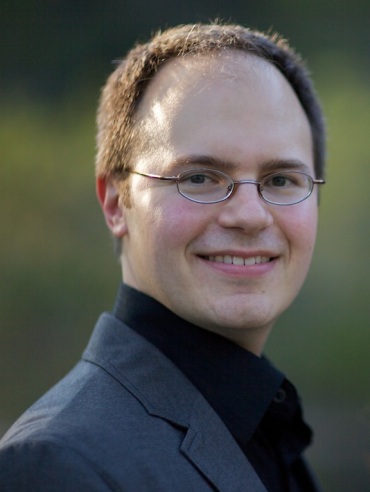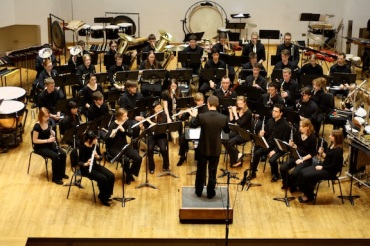The Well-Tempered Ear
Classical music Q&A: American composer Steven Bryant explains why wind and brass bands don’t get more respect as serious music ensembles, even as he prepares for a residency and a premiere this week at the University of Wisconsin-Madison.
1 Comment
By Jacob Stockinger
Starting this Wednesday, American composer Steven Bryant (below, b. 1972) will be in residence at the University of Wisconsin School of Music.
His residency, which organizers say should help attract the public’s attention to band music at the UW, will culminate in a FREE concert on Saturday night at 8 p.m. in Mills Hall. Bryant will be present.
That is also when the UW Wind Ensemble (below top, rehearsing) will be joined by the Wisconsin Brass Quintet to perform several works by contemporary composers. They include “Firefly” by Ryan George (b. 1978); “Concerto 2010” for Wind Ensemble and Brass Quintet by Anthony Plog (b. 1947); “Hymn to a Blue Hour by John Mackey (b. 1973) ;” and the Wisconsin premiere of Bryant’s Concerto for Wind Ensemble (2010), conducted by Scott Teeple. The Wisconsin Brass Quintet (below bottom), which is celebrating its 40th anniversary this season as artists-in-residence at the UW, will join the UW Wind Ensemble.
Even while Bryant (below) was doing another residency in Indianapolis, he agreed to an email Q&A with The Ear about his upcoming residency at the UW-Madison:
Could you briefly introduce yourself to the public?
I’m a freelance composer and occasional conductor, living in Durham, North Carolina, where my wife is on the faculty at Duke University. I am still in awe at my good fortune to be able to make my living doing exactly what I want to do.
Why do you think much of the classical music public doesn’t take bands – that is winds and brass – as seriously as say strings, piano, voice, etc.? What can be done about that and to heighten the profile of bands?
Historically, bands have been either military (playing only marches and ceremonial music) or community ensembles, with no set instrumentation or symphonic repertoire. Today, the most visible manifestation of bands, at least in the US, is marching bands at football games. (For information about the UW-Madison band program, visit: http://www.music.wisc.edu/bands)
Part of the problem is the lack of repertoire of music created expressly for the ensemble, and a lack of professional ensembles to present the music to the public.
However, the number of serious composers writing for band (or wind ensemble, or wind symphony, or wind orchestra -– whatever you want to call it!) has increased dramatically in the last 20 or 30 years, and the performance level of the top university ensembles now rivals professional playing, so I hope this view is changing. (Below is a photo of the UW Wind Ensemble performing.)
I view the band (and encourage composers who have never considered it as a potential medium to do the same) as a large new music ensemble with infrastructure behind it. The sheer number of ensembles in the US and around the world, and their eager interest in new music, means you have a much better chance at receiving multiple performances.
What would you like to say about your new Concerto for Wind Ensemble that received its world premiere in 2010 by the Wind Ensemble at the University of Texas-Austin (below is a photo of rehearsals for that Texas performance, and at bottom Bryant introduces his YouTube videos about composing the concerto) and which will receive its Wisconsin premiere Saturday night ? What special things should the public listen for or pay attention to?
In my Concerto for Wind Ensemble I set out to create a lot of music from a very small amount of source material. Most of the music you’ll hear throughout all five movements is presented in the first half of Movement I.
The other material is introduced in Movement III, which is built entirely from a Trumpet solo my father played years ago, and which I transcribed from an old cassette tape a couple of years after he passed away. At one point, the Trumpet and the Sax (my instrument) play the nearly intact solo together.
If you want to know more about the work and its performance history, you can go to my website:
http://stevenbryant.com/concertoforwindensemble.php
What there an Aha! Moment – perhaps a piece or performer or composer – when you knew you wanted to become a professional composer and musician?
Music was always around the house, since my father was a gigging musician as well as a band director and music educator. I was fascinated from an early age with the act of writing music on a staff, even before I quite knew what the notes were.
One specific catalyst that pushed me into writing was Bruce Hornsby’s single, “The Way It Is.” I was in middle school, and decided I wanted to learn to play it, so I sat at the piano and figured it out. From there, I started writing my own (truly awful) pop songs, followed by pep band arrangements of early Chicago tunes, cheesy “new age” synth pieces in high school, and then a brass quartet and ultimately a piece for my high school band.
I made no distinction in my mind among these – they were all simply the fascinating act of creating and writing down music.
Want would you like to say about the UW-Madison and Madison – ties you have, things you have heard or know about?
I’ve never been on the campus of UW-Madison, and have only been in the city of Madison one time for about eight hours, so I’m very much looking forward to my visit!





